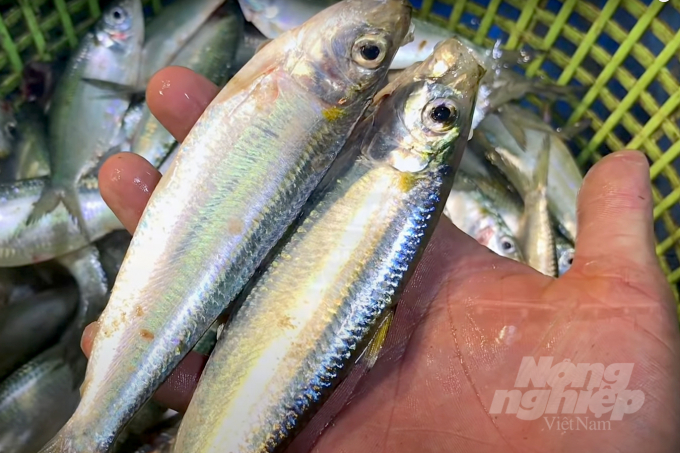November 27, 2025 | 10:40 GMT +7
November 27, 2025 | 10:40 GMT +7
Hotline: 0913.378.918
November 27, 2025 | 10:40 GMT +7
Hotline: 0913.378.918

Herring is harvested in the waters of Ba Ria - Vung Tau. Photo: Thanh Son.
According to the Vietnam Association of Seafood Exporters and Producers (VASEP), in the first quarter of this year, among key seafood, the export growth of marine fish (except tuna), was relatively modest with only a slight increase of five per cent. Meanwhile, most of the key seafoods saw strong growth such as tuna by 72 per cent, crabs and other crustaceans 62 per cent, squid, octopus 35 per cent.
Sea fish still held the top position in terms of export value of seafood products when reaching $421 million, accounting for 45.76 per cent of the total seafood export value in the first quarter - over $920 million.
Not only in the first quarter of this year but also in previous years, marine fish always accounted for the largest proportion of seafood exports. In 2021, the export of other marine fish accounts for about 50 per cent of the total seafood export value of $3.4 billion.
The export value of other marine fish in the past year reached about $1.7 billion higher than pangasius. This shows the importance of other marine fish in the structure of export seafood in particular and Vietnam's export seafood in general. The demand in the world market for this commodity group is quite large.
However, due to the limitation of raw materials, the export of other marine fish could not increase sharply. Among other marine fish, there are currently only a few types of fish that domestic production and exploitation can meet the export demand such as herring, and anchovies.
In terms of herring, currently, each year, Vietnamese seafood enterprises earn tens of millions of USD. Information from VASEP shows that in 2021, the export value of herring reached $37.5 million. There are 30 markets importing herring from Vietnam, in which, the US, Thailand, Japan, Korea and Australia markets account for a dominant proportion with nearly 76 per cent of export value.
After falling last year, herring exports earlier this year are increasing slightly again (up 2.5 per cent in the first 2 months of the year), of which exports to the US increased by 30 per cent, to South Korea increased by 67 per cent, to Australia increased by 86 per cent.
The source of raw herring is currently quite abundant and the demand is high in the world market, leading to Vietnam’s increasing herring export. Therefore, herring still has many export prospects in the coming months.
Demand for other marine fish is still growing in key export markets. The evidence is that many marine fish processing orders are transferred from Chinese factories to Vietnam.
The import of seafood to Vietnam which is mainly raw seafood for export processing, in the past few months has shown quite clearly the demand for processing and exporting fish of other types in particular and seafood in general.
According to the General Department of Customs, in March 2022, seafood imports increased sharply by 34.6 per cent compared to February 2022. For the whole first quarter, seafood imports reached $545 million, up 9.2 per cent compared to the first quarter of last year.
Among the ten largest seafood supply markets for Vietnam in the first quarter of this year, there are major export markets for marine fish such as Japan, Indonesia, Taiwan, Korea, Russia, and Chile. This shows the import demand of sea fish for export processing is quite large.
Therefore, to promote the export of other types of fish in particular and seafood in general, Truong Dinh Hoe, General Secretary of VASEP said that it was necessary to create more favorable conditions for the import of raw seafood for export processing, consider importing raw seafood as an important factor to promote seafood export.
If the import of raw seafood is done well, each year, the export value of seafood in general can increase by several billion USD compared to the present.
Translated by Hien Anh

(VAN) China’s cooking oil is suddenly flooding into India. It all comes down to a soybean surplus that Beijing doesn’t quite know what to do with.

(VAN) An Giang promotes supply-demand connections, standardizes quality and builds value chains, creating a foundation for sustainable bird’s nest development and aiming to expand exports.
/2025/11/24/5339-4-nongnghiep-075331.jpg)
(VAN) Recently, the conference on 'Sustainable Fisheries Linkage Chain - Tilapia for Export' took place in Tien Hai commune, Hung Yen province.
/2025/11/21/4309-2-153400_128.jpg)
(VAN) Green and low-emission rice is paving the way for Vietnamese rice to enter high-end markets, marking the beginning of a transformation journey toward greening and elevating the national rice brand.

(VAN) ‘Right to Win’ outlines a national action plan that shapes a new vision for Viet Nam’s agriculture in an era of renewal and global integration.

(VAN) Lam Dong’s farmed sturgeon output this year is expected to reach 2,300 tons, worth VND 450 billion, affirming the brand’s position on the market.

(VAN) A surge in Ukrainian egg exports, largely driven by soaring sales to the UK over the last few years, has notably pushed up egg prices on the domestic market.